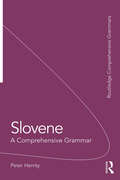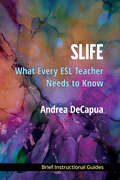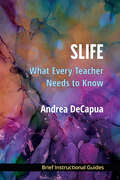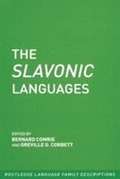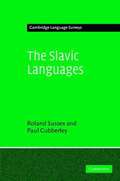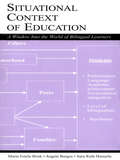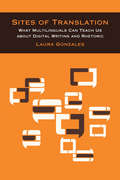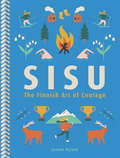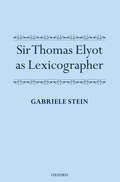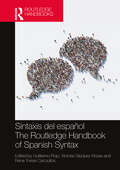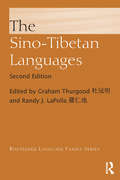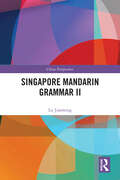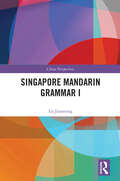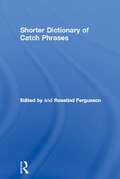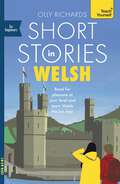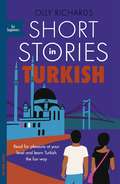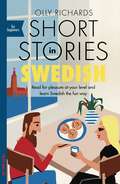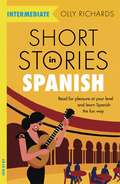- Table View
- List View
Slovene: A Comprehensive Grammar (Routledge Comprehensive Grammars)
by Peter HerritySlovene: A Comprehensive Grammar is the most complete reference guide to the contemporary language. Key features of this new edition include: updated examples reflecting current usage, expanded discussions of particular areas of difficulty, a brief history of the language, dialects and register, clear distinction between written and spoken usage, new tables and charts for quick reference. The Grammar provides a jargon-free and systematic description of all parts of speech promoting an in-depth understanding of the Slovene language. Slovene: A Comprehensive Grammar is a key resource for linguists and students of Slovene at intermediate and advanced levels.
Slovene: A Comprehensive Grammar (Routledge Comprehensive Grammars)
by Peter HerritySlovene: A Comprehensive Grammar is the most complete reference guide to the contemporary language. Key features of this new edition include: updated examples reflecting current usage, expanded discussions of particular areas of difficulty, a brief history of the language, dialects and register, clear distinction between written and spoken usage, new tables and charts for quick reference. The Grammar provides a jargon-free and systematic description of all parts of speech promoting an in-depth understanding of the Slovene language. Slovene: A Comprehensive Grammar is a key resource for linguists and students of Slovene at intermediate and advanced levels.
SLIFE: What Every Teacher Needs to Know
by Andrea DeCapuaSLIFE: What Every Teacher Needs to Know helps readers deepen their understanding of Students with Limited or Interrupted Formal Education (SLIFE). Because of their limited, greatly interrupted, or sometimes nonexistent participation in formal education, SLIFE face challenges in the classroom that go beyond language and content. Often SLIFE need to develop basic literacy skills and foundational subject-area knowledge, as well as to learn how to engage in the discourse and practices of formal educational settings. So what can teachers do to help these students succeed and to recognize and honor their knowledge, skills, and cultural capital? SLIFE: What Every Teacher Needs to Know centers around four guidelines for teaching SLIFE: question assumptions, foster two-way communication, explicitly teach school tasks and academic ways of thinking, and promote project-based learning. Discussion of the Mutually Adaptive Learning Paradigm (MALP), is also included.
SLIFE: What Every Teacher Needs to Know
by Andrea DeCapuaSLIFE: What Every Teacher Needs to Know helps readers deepen their understanding of Students with Limited or Interrupted Formal Education (SLIFE). Because of their limited, greatly interrupted, or sometimes nonexistent participation in formal education, SLIFE face challenges in the classroom that go beyond language and content. Often SLIFE need to develop basic literacy skills and foundational subject-area knowledge, as well as to learn how to engage in the discourse and practices of formal educational settings. So what can teachers do to help these students succeed and to recognize and honor their knowledge, skills, and cultural capital? SLIFE: What Every Teacher Needs to Know centers around four guidelines for teaching SLIFE: question assumptions, foster two-way communication, explicitly teach school tasks and academic ways of thinking, and promote project-based learning. Discussion of the Mutually Adaptive Learning Paradigm (MALP), is also included.
The Slavonic Languages (PDF)
by Bernard Comrie Greville G. Corbett Victor Friedman Lenore GrenobleIn this scholarly volume, each of the living Slavonic languages are analysed and described in depth, together with the two extinct languages - Old Church Slavonic and Polabian. In addition, the various alphabets of the Slavonic languages - particularly Roman, Cyrillic and Glagolitic - are discussed, and the relationships of the Slavonic languages to other Indo-European languages and to one another, are explored. The last chapter provides an account of those Slavonic languages in exile, for example, Russian, Ukrainian, Polish, Czech and Slovak in the USA. Each language-chapter is written by an expert in the field, in a format designed for comparative study. Information on each language includes: an introductory description of social context and development (where appropriate); a discussion of phonology; a detailed presentation of synchronic morphology, noting major historical developments; comprehensive treatment of syntactic properties; a discussion of vocabulary; an outline of main dialects; and an extensive bibliography, listing English and other sources.
The Slavic Languages (PDF)
by Roland Sussex Paul CubberleyThe Slavic group of languages - the fourth largest Indo-European sub-group - is one of the major language families of the modern world. With 297 million speakers, Slavic comprises 13 languages split into three groups: South Slavic, which includes Bosnian, Serbian and Croatian; East Slavic, which includes Russian and Ukrainian; and West Slavic, which includes Polish, Czech and Slovak. This 2006 book, written by two leading scholars in Slavic linguistics, presents a survey of all aspects of the linguistic structure of the Slavic languages, considering in particular those languages that enjoy official status. As well as covering the central issues of phonology, morphology, syntax, word-formation, lexicology and typology, the authors discuss Slavic dialects, sociolinguistic issues, and the socio-historical evolution of the Slavic languages. Accessibly written and comprehensive in its coverage, this book will be welcomed by scholars and students of Slavic languages, as well as linguists across the many branches of the discipline.
Situational Context of Education: A Window Into the World of Bilingual Learners
by Mar¡a Estela Brisk Angela Burgos Sara Ruth HamerlaThis book gives educators important answers to the urgent question of how teachers and schools can facilitate language minority and immigrant students' progress in school. It offers an innovative and powerful method teachers and students can use to study the situational context of education, providing both the theoretical background and the practical tools to implement this approach. The situational context of education includes linguistic, economic, social, cultural, and political factors, as well as conditions, such as students' personal characteristics, family support, and quality of instruction. All of these factors influence the lives of students and their academic performance and contribute in many ways, some subtle and indirect, to making the educational experience more or less difficult for different students. The premise of the book is that objective study of the situational context of education by both students and teachers is beneficial because it leads to a more realistic view of how to facilitate students' progress in school. Designed as a text for graduate courses for preservice and in-service teachers working with students in bilingual, ESL, mainstream, and special education classrooms, the goal is to engage readers in learning not only from the literature but also from studying the situational contexts of their own students. The focus here is on the factors that affect language minority and immigrant students in the United States, but the framework is equally powerful for work with student populations in other social contexts. *The Introduction includes an overview of the theory behind the study of the situational context of education and the implementation of this approach; describes the context of the pilot lessons included in the book; and explains how to use the lessons detailed in later chapters. *Chapters 2-6 focus on different factors in the situational context of education: linguistic, economic, social, cultural, and political. A three-part structure is used: "Classroom Implementation" (a rich description of one lesson in a real classroom); "Context Variables" (a theoretical explanation of the specific factor the chapter addresses, providing the research basis for the sample lesson objectives ); "Doing Analysis of the Context" (several sample lessons for implementation). The lessons are addressed to the teacher, with detailed ideas on how to carry out the lesson and evaluate the students' understanding of the situational context. *Five Appendices provide helpful resources for the implementation of the lessons: an Annotated bibliography of relevant K-12 children's literature; Instructional Approaches; Scoring Rubrics for Content Objectives; Guidelines for a Contrastive Study of Situational Context; and Lesson Template. The lessons have been thoroughly field-tested with students and teachers. Because these lessons work on multiple levels, Situational Context of Education: A Window Into the World of Bilingual Learners benefits students from first grade through preservice and in-service teachers in university courses. Teachers get to know their students and their predicaments within the social context of the United States, and at the same time, the lesson activities have a great impact on the students in their classes. All are helped to achieve academically while gaining awareness of situational factors affecting their lives.
Situational Context of Education: A Window Into the World of Bilingual Learners
by Mar¡a Estela Brisk Angela Burgos Sara Ruth HamerlaThis book gives educators important answers to the urgent question of how teachers and schools can facilitate language minority and immigrant students' progress in school. It offers an innovative and powerful method teachers and students can use to study the situational context of education, providing both the theoretical background and the practical tools to implement this approach. The situational context of education includes linguistic, economic, social, cultural, and political factors, as well as conditions, such as students' personal characteristics, family support, and quality of instruction. All of these factors influence the lives of students and their academic performance and contribute in many ways, some subtle and indirect, to making the educational experience more or less difficult for different students. The premise of the book is that objective study of the situational context of education by both students and teachers is beneficial because it leads to a more realistic view of how to facilitate students' progress in school. Designed as a text for graduate courses for preservice and in-service teachers working with students in bilingual, ESL, mainstream, and special education classrooms, the goal is to engage readers in learning not only from the literature but also from studying the situational contexts of their own students. The focus here is on the factors that affect language minority and immigrant students in the United States, but the framework is equally powerful for work with student populations in other social contexts. *The Introduction includes an overview of the theory behind the study of the situational context of education and the implementation of this approach; describes the context of the pilot lessons included in the book; and explains how to use the lessons detailed in later chapters. *Chapters 2-6 focus on different factors in the situational context of education: linguistic, economic, social, cultural, and political. A three-part structure is used: "Classroom Implementation" (a rich description of one lesson in a real classroom); "Context Variables" (a theoretical explanation of the specific factor the chapter addresses, providing the research basis for the sample lesson objectives ); "Doing Analysis of the Context" (several sample lessons for implementation). The lessons are addressed to the teacher, with detailed ideas on how to carry out the lesson and evaluate the students' understanding of the situational context. *Five Appendices provide helpful resources for the implementation of the lessons: an Annotated bibliography of relevant K-12 children's literature; Instructional Approaches; Scoring Rubrics for Content Objectives; Guidelines for a Contrastive Study of Situational Context; and Lesson Template. The lessons have been thoroughly field-tested with students and teachers. Because these lessons work on multiple levels, Situational Context of Education: A Window Into the World of Bilingual Learners benefits students from first grade through preservice and in-service teachers in university courses. Teachers get to know their students and their predicaments within the social context of the United States, and at the same time, the lesson activities have a great impact on the students in their classes. All are helped to achieve academically while gaining awareness of situational factors affecting their lives.
Sites of Translation: What Multilinguals Can Teach Us about Digital Writing and Rhetoric (Sweetland Digital Rhetoric Collaborative)
by Laura GonzalesWinner of the 2016 Sweetland Digital Rhetoric Collaborative Book Prize Sites of Translation illustrates the intricate rhetorical work that multilingual communicators engage in as they translate information for their communities. Blending ethnographic and empirical methods from multiple disciplines, Laura Gonzales provides methodological examples of how linguistic diversity can be studied in practice, both in and outside the classroom, and provides insights into the rhetorical labor that is often unacknowledged and made invisible in multilingual communication. Sites of Translation is relevant to researchers and teachers of writing as well as technology designers interested in creating systems, pedagogies, and platforms that will be more accessible and useful to multilingual audiences. Gonzales presents multilingual communication as intellectual labor that should be further valued in both academic and professional spaces, and supported by multilingual technologies and pedagogies that center the expertise of linguistically diverse communicators.
Sisu: The Finnish Art of Courage
by Joanna NylundDiscover the Finnish quality of sisu and how cultivating it can help you lead a life of greater purpose and happiness.This ancient Finnish word describes an attitude of courage, resilience, grit, tenacity and perseverance. This key psychological competence enables extraordinary action in times of adversity. To have sisu confers a further dimension of doing so with honesty, integrity and humility.By cultivating sisu you can: Face life's challenges with courage and determination Enhance your wellbeing and find your focus Communicate confidently and resolve conflicts effectively Cultivate endurance and achieve your fitness goals Raise kind and resilient children Act with integrity and fight for what you believe inSisu is a universal trait. It may have been bottled and labelled by the Finns, but it is within reach of everyone. It lies within you, and you are very likely to have used it already.
Sir Thomas Elyot As Lexicographer
by Gabriele SteinSir Thomas Elyot's Latin-English dictionary, published in 1538, became the leading work of its kind in England. Gabriele Stein describes this pioneering work, exploring its inner structure and workings, its impact on contemporary scholarship, and its later influence. The author opens with an account of Elyots life and publications. Sir Thomas Elyot (c. 1490-1546) was a humanist scholar and intellectual friend of Sir Thomas More. He was employed by Thomas Cromwell in diplomatic and official capacities that did more to impoverish than enrich him, and he sought to increase his income with writing. His treatise on moral philosophy, The Boke named the Governour, was published in 1531, and dedicated to Henry VIII. His popular treatise on medicine, The Castell of Helth, published some years later, went through seventeen editions. Professor Stein then considers how and why Elyot decided to compile a Latin-English dictionary. She looks at the guiding principles, the organization he devised, and the authors and texts he used as sources. She examines the books importance for the historical study of English, noting the lexical regionalisms and items of vulgar usage in the Promptuorum parvulorum and the dictionaries of Palsgrave and Elyot before discussing Elyots linking of lemma and gloss, and use of generic reference points. She explains how Elyot translated and defined the Latin headwords and compares his practice with his predecessors. The author ends with a detailed assessment of Elyots impact on sixteenth- and seventeenth-century dictionaries and his place in Renaissance lexicography. Her exploration of the work of an outstanding sixteenth-century scholar will interest historians of the English language, lexicography, and the intellectual climate of Tudor England.
Sintaxis del español / The Routledge Handbook of Spanish Syntax (Routledge Spanish Language Handbooks)
by Guillermo Rojo Victoria Vázquez Rozas Rena Torres CacoullosEl volumen Sintaxis del español/The Routledge Handbook of Spanish Syntax proporciona una visión general de los temas fundamentales de la sintaxis del español, basada en datos extraídos de corpus textuales, sensible a los fenómenos de variación y conectada con otros componentes de la lengua. La obra, escrita en español, reúne perspectivas teóricas diversas, elaboradas por un grupo internacional de lingüistas. Está dividida en seis partes y comprende 45 capítulos centrados en cuestiones teóricas, cláusulas, oraciones y estructuras supraoracionales, categorías verbales, frases y clases de palabras, variación y cambio sintácticos, así como acercamientos computacionales y sus diferentes aplicaciones. El volumen constituye una referencia fundamental para los investigadores al tiempo que proporciona una introducción accesible para estudiantes de la lengua y la lingüística españolas. Sintaxis del español / The Routledge Handbook of Spanish Syntax provides a comprehensive overview of topics in Spanish syntax, drawing on corpus-based data, incorporating variation, and connecting with other aspects of language. Written in Spanish, the volume brings together diverse theoretical perspectives from an international group of scholars. Divided into six parts, the book comprises 45 chapters on theoretical perspectives, clauses, sentences and (supra)sentential syntax, verb categories, phrases and word classes, syntactic variation and change, and computational approaches and their applications. This handbook is an essential reference for scholars and an accessible introduction for students of Spanish language and linguistics.
Sintaxis del español / The Routledge Handbook of Spanish Syntax (Routledge Spanish Language Handbooks)
by Guillermo Rojo Victoria Vázquez Rozas Rena Torres CacoullosEl volumen Sintaxis del español/The Routledge Handbook of Spanish Syntax proporciona una visión general de los temas fundamentales de la sintaxis del español, basada en datos extraídos de corpus textuales, sensible a los fenómenos de variación y conectada con otros componentes de la lengua. La obra, escrita en español, reúne perspectivas teóricas diversas, elaboradas por un grupo internacional de lingüistas. Está dividida en seis partes y comprende 45 capítulos centrados en cuestiones teóricas, cláusulas, oraciones y estructuras supraoracionales, categorías verbales, frases y clases de palabras, variación y cambio sintácticos, así como acercamientos computacionales y sus diferentes aplicaciones. El volumen constituye una referencia fundamental para los investigadores al tiempo que proporciona una introducción accesible para estudiantes de la lengua y la lingüística españolas. Sintaxis del español / The Routledge Handbook of Spanish Syntax provides a comprehensive overview of topics in Spanish syntax, drawing on corpus-based data, incorporating variation, and connecting with other aspects of language. Written in Spanish, the volume brings together diverse theoretical perspectives from an international group of scholars. Divided into six parts, the book comprises 45 chapters on theoretical perspectives, clauses, sentences and (supra)sentential syntax, verb categories, phrases and word classes, syntactic variation and change, and computational approaches and their applications. This handbook is an essential reference for scholars and an accessible introduction for students of Spanish language and linguistics.
The Sino-Tibetan Languages (Routledge Language Family Series)
by Graham Thurgood Randy J. LaPollaThere are more native speakers of Sino-Tibetan languages than of any other language family in the world. Our records of these languages are among the oldest for any human language, and the amount of active research on them has multiplied in the last few decades. Now in its second edition and fully updated to include new research, The Sino-Tibetan Languages includes overview articles on individual languages, with an emphasis on the less commonly described languages, as well as descriptions and comments on the subgroups in which they occur. There are overviews of the whole family on genetic classification and language contact, syntax and morphology, and also on word order typology. There are also more detailed overview articles on the phonology, morphosyntax, and writing system of just the Sinitic side of the family. Supplementing these overviews are articles on Shanghainese, Cantonese and Mandarin dialects. Tibeto-Burman is reviewed by genetic or geographical sub-group, with overview articles on some of the major groups and areas, and there are also detailed descriptions of 41 individual Tibeto-Burman languages, written by world experts in the field. Designed for students and researchers of Asian languages, The Sino-Tibetan Languages is a detailed overview of the field. This book is invaluable to language students, experts requiring concise, but thorough, information on related languages, and researchers working in historical, typological and comparative linguistics.
The Sino-Tibetan Languages (Routledge Language Family Series #1a)
by Graham Thurgood Randy J. LaPollaThere are more native speakers of Sino-Tibetan languages than of any other language family in the world. Our records of these languages are among the oldest for any human language, and the amount of active research on them has multiplied in the last few decades. Now in its second edition and fully updated to include new research, The Sino-Tibetan Languages includes overview articles on individual languages, with an emphasis on the less commonly described languages, as well as descriptions and comments on the subgroups in which they occur. There are overviews of the whole family on genetic classification and language contact, syntax and morphology, and also on word order typology. There are also more detailed overview articles on the phonology, morphosyntax, and writing system of just the Sinitic side of the family. Supplementing these overviews are articles on Shanghainese, Cantonese and Mandarin dialects. Tibeto-Burman is reviewed by genetic or geographical sub-group, with overview articles on some of the major groups and areas, and there are also detailed descriptions of 41 individual Tibeto-Burman languages, written by world experts in the field. Designed for students and researchers of Asian languages, The Sino-Tibetan Languages is a detailed overview of the field. This book is invaluable to language students, experts requiring concise, but thorough, information on related languages, and researchers working in historical, typological and comparative linguistics.
Singapore Mandarin Grammar II (China Perspectives)
by Lu JianmingAs the second volume of a two-volume set that presents a comprehensive syntactical picture of Singapore Mandarin, this title analyses various expressions relating to number, quantity, time and place, composite sentences and the characteristics and standardisation of Singapore Mandarin. The first two chapters discuss expressions of number, quantity, time and place in Singapore Mandarin and touch upon the differences in these expressions between Singapore and Chinese Mandarin (Putonghua). Composite sentences are then analysed, covering seven types of compound sentences and eight types of complex sentences, as well as connective words with a focus on conjunctions. The final part of the volume analyses the characteristics of Singapore Mandarin grammar compared with Chinese Mandarin, on the level of phrase, lexicon and sentence. From the perspectives of language contact, political and social contexts and bilingualism, it summarises the possible reasons for the differences between the two varieties of Chinese and points out primary challenges and major concerns of the standardisation of Singapore Mandarin. With rich and authentic language examples, the book will serve as a must read for learners and teachers of Mandarin Chinese and linguistics scholars interested in global Chinese and especially Singapore Mandarin.
Singapore Mandarin Grammar II (China Perspectives)
by Lu JianmingAs the second volume of a two-volume set that presents a comprehensive syntactical picture of Singapore Mandarin, this title analyses various expressions relating to number, quantity, time and place, composite sentences and the characteristics and standardisation of Singapore Mandarin. The first two chapters discuss expressions of number, quantity, time and place in Singapore Mandarin and touch upon the differences in these expressions between Singapore and Chinese Mandarin (Putonghua). Composite sentences are then analysed, covering seven types of compound sentences and eight types of complex sentences, as well as connective words with a focus on conjunctions. The final part of the volume analyses the characteristics of Singapore Mandarin grammar compared with Chinese Mandarin, on the level of phrase, lexicon and sentence. From the perspectives of language contact, political and social contexts and bilingualism, it summarises the possible reasons for the differences between the two varieties of Chinese and points out primary challenges and major concerns of the standardisation of Singapore Mandarin. With rich and authentic language examples, the book will serve as a must read for learners and teachers of Mandarin Chinese and linguistics scholars interested in global Chinese and especially Singapore Mandarin.
Singapore Mandarin Grammar I (China Perspectives)
by Lu JianmingAs the first volume of a two-volume set that presents a comprehensive syntactical picture of Singapore Mandarin, this title discusses the distinguishing characteristics of the Chinese language and describes the grammar of Singapore Mandarin. The book first provides an overview of the grammar of Singapore Mandarin and compares it with Chinese Mandarin (Putonghua). As a variety of Mandarin Chinese, Singapore Mandarin is also characterised by syntactic rules taking precedence over morphological rules. Therefore, it is argued that word order and functional words are specifically important in the study of Singapore Mandarin. Then the author explicates the properties and functions of the following nine grammatical components: the five most basic phrase types, word classes, sentences, subjects and predicates, predicates and objects, predicates and complements, attributes and adverbials, complex predicate phrases, and prepositions and prepositional phrases. With rich and authentic language examples, the book will serve as a must-read for learners and teachers of Mandarin Chinese and linguistics scholars interested in global Chinese and especially Singapore Mandarin.
Singapore Mandarin Grammar I (China Perspectives)
by Lu JianmingAs the first volume of a two-volume set that presents a comprehensive syntactical picture of Singapore Mandarin, this title discusses the distinguishing characteristics of the Chinese language and describes the grammar of Singapore Mandarin. The book first provides an overview of the grammar of Singapore Mandarin and compares it with Chinese Mandarin (Putonghua). As a variety of Mandarin Chinese, Singapore Mandarin is also characterised by syntactic rules taking precedence over morphological rules. Therefore, it is argued that word order and functional words are specifically important in the study of Singapore Mandarin. Then the author explicates the properties and functions of the following nine grammatical components: the five most basic phrase types, word classes, sentences, subjects and predicates, predicates and objects, predicates and complements, attributes and adverbials, complex predicate phrases, and prepositions and prepositional phrases. With rich and authentic language examples, the book will serve as a must-read for learners and teachers of Mandarin Chinese and linguistics scholars interested in global Chinese and especially Singapore Mandarin.
Shorter Dictionary of Catch Phrases
by Rosalind FergussonThis collection will appeal to everyone who has ever wondered about the origin of phrases like "all part of life's rich pattern" and "long time no see". It covers a wide range of catch phrases in current use in all parts of the English-speaking world. Most entries are drawn from the second edition of Eric Partridge's Dictionary of Catch Phrases (second edition, edited by Paul Beale), but have been completely rewritten in the light of recent research, and there are many additions. Catch Phrases include: close your eyes and think of England! have I got news for you! ... refreshes the parts that other ... cannot reach some mothers do'ave'em! you are awful, but I like you.
Shorter Dictionary of Catch Phrases: From The Work Of Eric Partridge And Paul Beale
by Rosalind FergussonThis collection will appeal to everyone who has ever wondered about the origin of phrases like "all part of life's rich pattern" and "long time no see". It covers a wide range of catch phrases in current use in all parts of the English-speaking world. Most entries are drawn from the second edition of Eric Partridge's Dictionary of Catch Phrases (second edition, edited by Paul Beale), but have been completely rewritten in the light of recent research, and there are many additions. Catch Phrases include: close your eyes and think of England! have I got news for you! ... refreshes the parts that other ... cannot reach some mothers do'ave'em! you are awful, but I like you.
Short Stories in Welsh for Beginners: Read for pleasure at your level, expand your vocabulary and learn Welsh the fun way! (Readers)
by Olly RichardsAn unmissable collection of eight unconventional and captivating short stories for young and adult learners of Swedish."Olly's top-notch language-learning insights are right in line with the best of what we know from neuroscience and cognitive psychology about how to learn effectively. I love his work - and you will too!" - Barbara Oakley, PhD, Author of New York Times bestseller A Mind for Numbers Short Stories in Welsh for Beginners has been written especially for students from high-beginner to low-intermediate level, designed to give a sense of achievement, a feeling of progress and most importantly - enjoyment! Mapped to A1-B1 on the Common European Framework of Reference (CEFR) for languages, these eight captivating stories are designed to give you a sense of achievement and a feeling of progress when reading.What does this book give you?- Eight stories in a variety of exciting genres, from science fiction and crime to history and thriller - making reading fun, while you learn a wide range of new vocabulary- Controlled language at your level to help you progress confidently- Realistic spoken dialogues to help you learn conversational expressions and improve your speaking ability- Accessible grammar so you learn new structures naturally, in a stress-free way- Pleasure! Research shows that if you're enjoying reading in a foreign language, you won't experience the usual feelings of frustration - 'It's too hard!' 'I don't understand!'Carefully curated to make learning a new language easy, these stories include key features that will support and consolidate your progress, including: - A glossary for bolded words in each chapter- Full plot summary- A bilingual word list- Comprehension questions after each chapter. As a result, you will be able to focus on enjoying reading, delighting in your improved range of vocabulary and grasp of the language, without ever feeling overwhelmed. From science fiction to fantasy, to crime and thrillers, Short Stories in Welsh for Beginners will make learning Welsh easy and enjoyable.
Short Stories in Turkish for Beginners: Read for pleasure at your level, expand your vocabulary and learn Turkish the fun way! (Foreign Language Graded Reader Series)
by Olly RichardsAn unmissable collection of eight unconventional and captivating short stories for young and adult learners of Turkish."Olly's top-notch language-learning insights are right in line with the best of what we know from neuroscience and cognitive psychology about how to learn effectively. I love his work - and you will too!" - Barbara Oakley, PhD, Author of New York Times bestseller A Mind for NumbersShort Stories in Turkish for Beginners has been written especially for learners from high-beginner to low-intermediate level, designed to give a sense of achievement, and most importantly - enjoyment! Mapped to A2-B1 on the Common European Framework of Reference (CEFR) for languages, these eight captivating stories will both entertain you, and give you a feeling of progress when reading.What does this book give you?· Eight stories in a variety of exciting genres, from science fiction and crime to history and thriller - making reading fun, while you learn a wide range of new vocabulary· Controlled language at your level to help you progress confidently· Realistic spoken dialogues to help you learn conversational expressions and improve your speaking ability· Accessible grammar so you learn new structures naturally, in a stress-free way· Beautiful illustrations accompanying each story, to set the scene and support your understanding· Pleasure! Research shows that if you're enjoying reading in a foreign language, you won't experience the usual feelings of frustration - 'It's too hard!' 'I don't understand!'Carefully curated to make learning a new language easy, these stories include key features that will support and consolidate your progress, including:· A glossary for bolded words in each chapter· A bilingual word list· Full plot summary· Comprehension questions after each chapter. As a result, you will be able to focus on enjoying reading, delighting in your improved range of vocabulary and grasp of the language, without ever feeling overwhelmed. From science fiction to fantasy, to crime and thrillers, Short Stories in Turkish for Beginners will make learning Turkish easy and enjoyable.
Short Stories in Swedish for Beginners: Read for pleasure at your level, expand your vocabulary and learn Swedish the fun way! (Foreign Language Graded Reader Series)
by Olly RichardsAn unmissable collection of eight unconventional and captivating short stories for young and adult learners of Swedish."Olly's top-notch language-learning insights are right in line with the best of what we know from neuroscience and cognitive psychology about how to learn effectively. I love his work - and you will too!" - Barbara Oakley, PhD, Author of New York Times bestseller A Mind for Numbers Short Stories in Swedish for Beginners has been written especially for students from high-beginner to low-intermediate level, designed to give a sense of achievement, a feeling of progress and most importantly - enjoyment! Mapped to A1-B1 on the Common European Framework of Reference (CEFR) for languages, these eight captivating stories are designed to give you a sense of achievement and a feeling of progress when reading.What does this book give you?- Eight stories in a variety of exciting genres, from science fiction and crime to history and thriller - making reading fun, while you learn a wide range of new vocabulary- Controlled language at your level to help you progress confidently- Realistic spoken dialogues to help you learn conversational expressions and improve your speaking ability- Accessible grammar so you learn new structures naturally, in a stress-free way- Pleasure! Research shows that if you're enjoying reading in a foreign language, you won't experience the usual feelings of frustration - 'It's too hard!' 'I don't understand!'Carefully curated to make learning a new language easy, these stories include key features that will support and consolidate your progress, including: - A glossary for bolded words in each chapter- Full plot summary- A bilingual word list- Comprehension questions after each chapter. As a result, you will be able to focus on enjoying reading, delighting in your improved range of vocabulary and grasp of the language, without ever feeling overwhelmed. From science fiction to fantasy, to crime and thrillers, Short Stories in Swedish for Beginners will make learning Swedish easy and enjoyable.
Short Stories in Spanish for Intermediate Learners: Read for pleasure at your level, expand your vocabulary and learn Spanish the fun way! (Foreign Language Graded Reader Series)
by Olly RichardsAn unmissable collection of eight unconventional and captivating short stories for young adult and adult intermediate learners of Italian.Olly's top-notch language-learning insights are right in line with the best of what we know from neuroscience and cognitive psychology about how to learn effectively. I love his work - and you will too! - Barbara Oakley, PhD, Author of New York Times bestseller A Mind for NumbersShort Stories in Italian for Intermediate Learners has been written specifically for students from a low-intermediate to intermediate level, designed to give a sense of achievement, and most importantly - enjoyment! Mapped to B1-B2 of the Common European Framework of Reference, these eight captivating stories will both entertain you, and give you a feeling of progress when reading.What does this book give you?· Eight stories in a variety of exciting genres, from science fiction and crime to history and thriller - making reading fun, while you learn a wide range of new vocabulary· Controlled language at your level to help you progress confidently· Realistic spoken dialogues to help you learn conversational expressions and improve your speaking ability· Beautiful illustrations accompanying each story, to set the scene and support your understanding· Accessible grammar so you learn new structures naturally, in a stress-free way· Pleasure! Research shows that if you're enjoying reading in a foreign language, you won't experience the usual feelings of frustration - 'It's too hard!' 'I don't understand!'With intriguing plots that will spark your imagination and keep you reading, Short Stories in Italian will take your grasp of Italian to the next level with key features to support and consolidate your progress, including:· A glossary for bolded words in each text· A bilingual word list· Full plot summary· Comprehension questions after each chapter. As a result, you will be able to focus on enjoying reading, delighting in your improved range of vocabulary and grasp of the language all without ever feeling overwhelmed. From science fiction to fantasy, to crime and thrillers, Short Stories in Italian for Intermediate Learners uses reading as the perfect tool to not only delight in learning Italian, but to accelerate your journey towards fluency.
